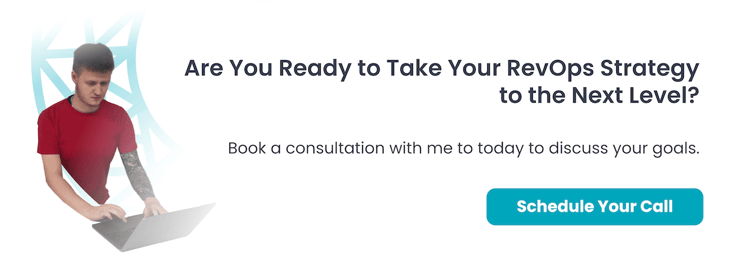How To Create Client Success Processes Inside Revenue Operations
*Data suggests that existing customers account for between a third to half of total revenue growth, even for start-ups. That makes customer success a key priority for businesses with growth ambitions. It’s also worth noting that growing revenue from an existing customer costs less than acquiring a new customer.
Back in 2018, McKinsey declared that we had entered a new era: customer success 2.0 as the new growth engine. For RevOps, customer success is not just a matter of successfully selling a product or service.
It requires a comprehensive approach to customer relationship management, with the goal of building longer-term relationships that add value to the customer by cultivating a customer-focused mindset across the business. That, in turn, drives business growth.
Identifying and addressing customer needs, then devising a process to add value, reduce churn and nurture brand loyalty demands time and expertise, but it is well worth the investment: a repeat customer offers greater revenue prospects than a one-time buyer - particularly if they subsequently bring in more clients via word of mouth.
Through this process, you can effectively turn your clients into your strongest, most passionate and most authentic brand advocates.
The first step towards creating a client success process inside RevOps is to define your client success goals. To do so, you’ll need to articulate the precise objectives of your client success programme.
Is it your aim to improve customer satisfaction levels for example? Are you keen to improve customer retention rates? Or are you looking to increase upselling opportunities?
Identifying specific goals provides a clear direction for the project, define priorities, and increase the odds of achieving a successful outcome.
Once your specific client success goals have been defined, this success (or lack thereof) will need to be measured. In order to do so, it is important to establish client success metrics, or key performance indicators (KPI).
For example, you may want to keep an eye on customer satisfaction scores during post-purchase surveys, or customer retention rates over certain timeframes.
With the goals clear in mind and the KPIs established to measure progress,
you can embark on the next stage: developing your client success process.
This means creating a set of procedures to identify and address customer needs, manage customer feedback, and provide effective customer support as required.
A common example is asking customers for their feedback in order to improve the service.
Of course, all your client success processes need to be integrated with your sales and marketing strategy: after all, the strategic integration of sales, marketing and service departments is at the heart of RevOps.
By integrating your client success processes with your revenue operations, you can ensure that your efforts are focused on driving revenue growth and enhancing customer satisfaction across all teams.
There is another important factor that can make or break your client success programme: the team implementing it.
Or rather, teams. Customer success can’t happen in silo. From sales to the marketing team to your customer service agents, each person must be focused on delivering an enhanced customer experience. Once missing link in the chain could compromise your entire strategy.
Finally, it is important to regularly monitor your client success programme, and optimise it as needed. This is where your KPIs, and the data their analysis provides, once again come into play.
By monitoring and optimising your client success programme, you can continuously improve your customer relationships - and drive revenue growth. So, in more practical terms, how is all the above achieved? Let’s find out.
The Inbound Service Framework
The inbound service framework is a customer-centric approach to providing service and support to customers, based on the principles of inbound marketing, which operates by attracting, engaging and delighting customers.
The Inbound Service Framework takes this approach up a notch, applying it not to marketing activities but to customer service.
The Inbound Service Framework is designed to create a seamless and positive experience for customers throughout their entire customer journey.
The first three stages of the Inbound Service Framework are the same as the Inbound Methodology Flywheel stages of inbound marketing. These are:
-
Attract customers to your business. This involves creating content that addresses customer needs and interests and optimising your website and social media channels for search engines.
By providing valuable information and resources, you can attract customers who are looking for solutions to their problems. -
Engage with customers who have expressed an interest in your business. This involves providing personalised and relevant experiences, such as tailored email campaigns or chatbot interactions.
At no point should the client feel as though they are receiving the same standard responses and content as any other customer.
Personalisation of the entire experience is a vital part of building relationships with your customers. By engaging with customers in a meaningful way, you can create a positive experience, a prerequisite for building trust and loyalty. -
Delight customers by providing exceptional service and support. This means being proactive in addressing customer needs and concerns, and providing quick and effective solutions to their problems.
Delighting customers also calls for a proactive approach, where potential issues are resolved before they can mature into problems.All customers expect to receive the product or service they are paying for; in order to delight, you need to go above and beyond to exceed customer expectations.
Keep in mind, this is easier said than done: research has long established that while 80% of companies believe they're delivering 'superior' customer service, only 8% of customers believe they have received superior customer service.
-
Support customers throughout their entire customer journey. This is the extra step that is not part of the inbound flywheel and is specific to customer support.
As well as prompt and comprehensive responses to queries, you should aim to offer easily accessible, clear guidance and create online spaces where customers can interact with the business and with other customers.
Ongoing support creates a sense of community and can build customer loyalty while establishing your business as a trusted partner rather than ‘just’ a service provider.
The inbound service framework takes time and effort to set up well, but when done correctly, has several benefits for businesses.
By attracting, engaging, delighting, and supporting customers throughout their entire customer journey, organisations can count on improved customer satisfaction, lower churn rates, and increased revenue.

Developing & Creating A Customer Journey Map
A customer journey map is a representation of the steps a customer takes when interacting with a business, from initial awareness of the product or service through to the consideration period, the decision to make the purchase, and through to to the post-purchase follow-up.
Developing a customer journey map helps businesses understand their customers' experiences, and is a valuable tool to identify opportunities for improvement.
You may think of it as a RevOPs version of the literary trope of the hero’s journey, where the hero is your customer. Before you can develop the map, you need to ask: who is this hero?
In order to have an accurate map, you need to have a clear representation of your typical customer, based on demographics such as age, gender, income, education, and location, and behaviour patterns of those who interact with your business.
For example, if your business sells bicycles and bicycle parts in Epsom, you will know that your ideal client resides in Surrey or at least within a certain radius and will be a bicycle enthusiast or at least a regular user.
Once you have defined your customer personas, it’s time to identify the touchpoints where customers interact with your business.
This may happen through your social media channels, via your website, in conversation with your sales team, in a physical bricks-and-mortar, as well as any form of post-purchase support.
With both your hero and the touchpoints defined, it is time to map the customer journey. You can do this through the creation of a timeline which charts each touchpoint and the actions your customers take at each stage.
Once the customer journey has been mapped, take a step back, look at the big picture, and see if you can identify opportunities to improve the customer experience.
For example, could you improve the contact form on your website to make it easier to complete or set up an automatic response to messages on social media advising customers that their message has been received and a response will be provided within a specific window?
You should also look for opportunities to create new touchpoints, improve response rates for existing ones, and streamline the checkout process.
After identifying and implementing these changes, outcomes will need to be continuously monitored to ascertain the impact of the change and where further opportunities for improvement exist.
As customer behaviour and expectations can change over time, it follows that developing and creating a customer journey map is an ongoing process that requires continuous reviews and updates.
Engaging the Modern Customer
Engaging the modern customer - who is tech-savvy, empowered, and places value on personalised experiences - is a complex and ongoing process. Engaging with modern consumers means businesses must work to understand their preferences, behaviours, and expectations.
The first step is understanding how the consumer prefers to interact with the business.
What are their preferred communication channels?
And their payment preferences?
These insights can be gathered through data analytics and form the basis for a more personalised customer experience.
Modern customers value personalised experiences, and meeting this demand helps to build trust, loyalty, and customer satisfaction. Personalisation can be achieved through email marketing, targeted advertising, and product recommendations.
Personalised recommendations, promotions, and content are far more effective than generic content which is not tailored to fit the customer. It’s important to get this right, with 71% of post-pandemic consumers expecting companies to deliver personalized interactions and 76% feeling frustrated when that doesn’t happen.
Modern customers interact with businesses through multiple channels, including via email, social media, websites, and mobile apps. It is important for businesses to keep all these channels open, creating a unified customer experience across all touchpoints.
Circumstances or preferences may require the same customer to contact a business through two or more different channels; allowing a seamless switch between channels without having to repeat previously disclosed information each time, is one way to deliver a more joined up experience.
Social media is a powerful tool to showcase your products or services, but it can be a lot more a place to post images and updates. Social networks can also help with customer relationship building.
Social media’s original intent wasn’t to serve as a shop window, it’s a concept that was inherently designed to help people stay in touch. A humanisation of your relationship with customers is crucial in order to stand out, allowing businesses to create both brand awareness and a sense of community.
Speaking of community: the modern customer places a high value on sustainability and social responsibility.
Deloitte research indicates a substantial increase in the number of people adopting a sustainable lifestyle over the last 12 months. This knowledge may not immediately appear relevant to the product or service your business has to offer, but that’s often not the case.
Prioritising sustainable initiatives, for example by promoting environmentally friendly practices, reducing waste, sourcing materials from local and sustainable sources, or even donating to good causes can go a long way towards helping modern consumers chose your business over a competitor.
After all, 72% of today’s consumers now factor in sustainability considerations when making purchasing decisions.
Of course, no amount of community building or sustainable policies will hold up if businesses do not also provide consistently excellent customer service, with quick and effective solutions to issues or concerns.
To truly create a customer success process with your RevOps, it’s important that you don’t overlook the importance of a two-way channel of communication.
The majority of consumers will provide precious feedback about their experience, whether positive or negative when asked.
Whether good or bad, this information is critical to understanding where you’re delighting your customers and where their experiences are falling short.
Don’t just wait for your customers to get in touch with you. Instead, build in a regular cycle of asking for feedback through surveys, reviews, and customer supported interactions.
Guiding Your Customers To Success With Content
Long-term profit, customer satisfaction, sustainable growth, and low churn are all signs of a successful business. Achieving those aims requires you to facilitate the customer journey and help them attain success.
Obviously, this refers to the customers’ success in relation to the product or service which the business offers; a high success rate for customers utilising your service will reflect well on your business, as well as making clients more likely to turn to you again for their future needs.
It’s a win/win situation - so what can an organisation do to guide customers to success with content?
A first step is to identify any obstacles or challenges that customers may encounter across their customer journey.
You can more easily identify these pain points by returning again to your customer feedback, survey responses, and data analytics tools.
Once the most common pain points have been identified, you can set about developing content that addresses those challenges.
The content can take various forms such as troubleshooting tips or downloadable step-by-step guides, but regardless of format, it should always be informative, relevant, and actionable, with practical solutions to help customers overcome the challenges they are facing.
Modern customers will tend to turn to self-service guides first with speaking to customer often the last resort. According to data from the Harvard Business Review, the percentage of people who will attempt to seek answers independently is as high as 81%.
Providing useful content empowers the customer to fix the problem quickly and feel good about their ability to address the issue, as well as keeping your customer service staff free to handle other enquiries.
This need becomes even more pronounced when you consider that 88% of consumers expect a customer service response within the hour, with 30% expecting a response within just 15 minutes.
Content should be easily accessible via your website, social media channels, and other relevant platforms such as mobile apps and online communities. You can use SEO tactics to ensure your content is easily discoverable.
The use of visuals to enhance your content is recommended: deeply informative content that presents itself as an endless wall of text on a web page is far from ideal.
Customers should be able to get as much information as possible by skimming the content, with helpful visuals to communicate complex concepts in a more accessible manner.
Personalisation is another powerful tool for guiding customers to success with content. Businesses can use customer data to personalise content based on the customer's interests, preferences, and behaviour.
As we saw earlier, this could include sending personalised emails, recommending relevant content, and providing customised product recommendations.
Throughout the content creation process, you’ll need to ensure that content is effectively guiding customers to success.
That can be achieved by continuous monitoring to measure its impact, tracking key performance indicators (KPIs) such as website traffic, engagement rates, and conversion rates as well as listening to customer feedback.
Based on this data, content can be continually optimised to better address customer pain points and drive successful outcomes.






%20-%20Teal.png?width=500&height=130&name=Force%20%26%20Friction%20-%20Branding%20-%20Logo%20(White)%20-%20Teal.png)